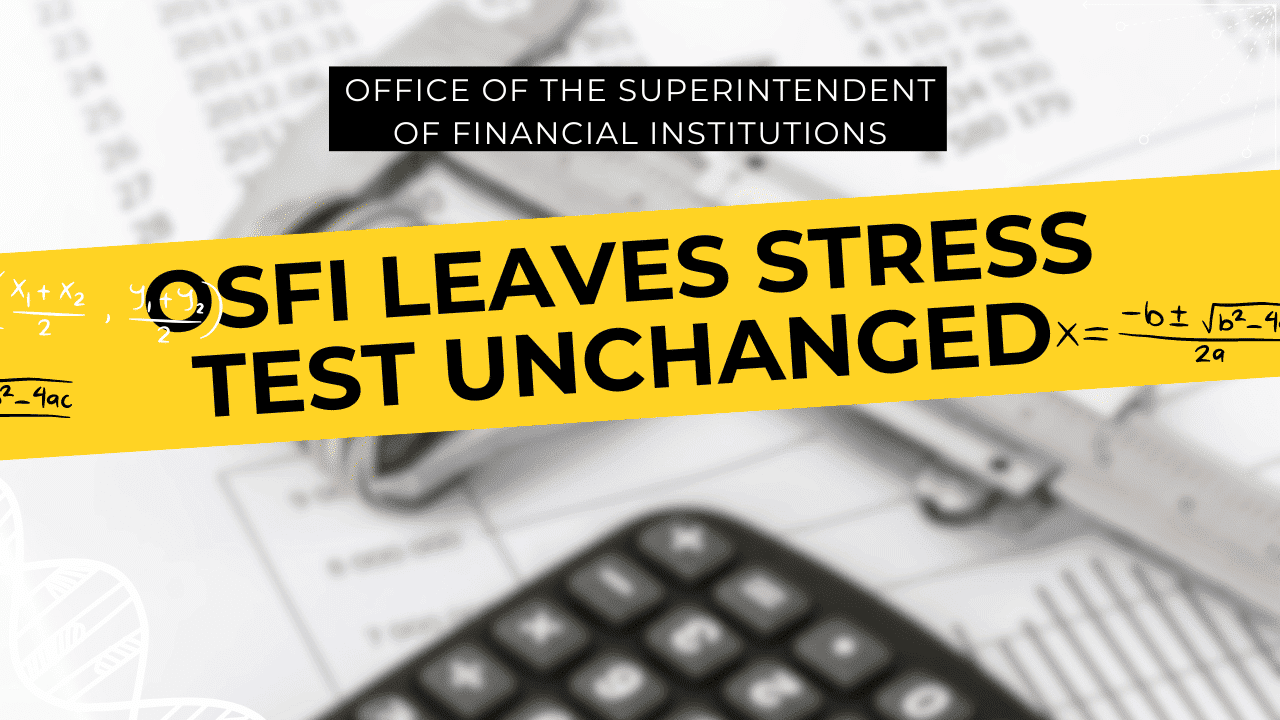In a significant move for the Canadian housing market, the Office of the Superintendent of Financial Institutions (OSFI) has recently announced its decision to leave the Mortgage Stress Test unchanged, particularly for uninsured mortgages. This decision arrives amidst a landscape of fluctuating mortgage rates and an evolving economic environment, sparking discussions and debates within the financial sector. The Mortgage Stress Test, a regulatory measure initially introduced to safeguard borrowers against potential financial strains, has been a focal point in considering how Canadians navigate the current and future housing market scenarios.
Watch on Youtube to LIKE and Subscribe!
Understanding the Mortgage Stress Test
The Mortgage Stress Test is a crucial tool used in the financial industry, primarily by senior management for strategic decision-making in areas like business strategy, risk management, and capital management decisions. Applicable to a wide range of financial institutions including banks, trust and loan companies, and insurance companies, stress testing evaluates the potential effects on an institution’s financial condition under specified changes in risk factors, reflecting exceptional but plausible events.
This risk management technique includes scenario testing and sensitivity testing, gaining importance in various economic conditions. Particularly valuable after long periods of stable economic conditions, stress testing helps institutions avoid complacency and underpricing of risk. It also plays a pivotal role during times of expansion, especially when new financial products emerge rapidly.
In practical terms, stress testing should be integrated into the institution’s enterprise-wide risk management. It serves multiple purposes such as risk identification and control, providing a complementary risk perspective to other risk management tools, supporting capital and liquidity management, and necessitating active involvement from senior management for effective operation and oversight.
Introduced as part of OSFI’s updated B-20 guidelines in 2018, the stress test is used by federally regulated lenders to qualify new mortgage borrowers and those wishing to switch lenders. The test requires borrowers to qualify at the higher of their contracted mortgage rate plus 200 basis points (2%) or 5.25%, known as the Minimum Qualifying Rate (MQR).
Recent Developments in the Mortgage Stress Test
Recently, the Office of the Superintendent of Financial Institutions (OSFI) has reaffirmed its stance on the Mortgage Stress Test for uninsured mortgages in Canada. In its annual review, OSFI announced that the minimum qualifying rate (MQR) for uninsured residential mortgages will remain the greater of 5.25% or the mortgage contract rate plus 2%. This decision is pivotal for mortgages generally requiring a down payment of more than 20%.
OSFI oversees this aspect of the mortgage stress test, while the Department of Finance handles the insured mortgages. The decision to maintain the MQR was based on data from ongoing monitoring of federally regulated financial institutions and various economic indicators. Peter Routledge, head of OSFI, commented on the decision, stating, “The minimum qualifying rate for uninsured mortgages has produced a more resilient residential mortgage financing system characterized by low default and delinquency rates. Holding the MQR at its current rate helps ensure that lenders and borrowers effectively manage the risks associated with residential mortgages”.
Exemption for Insured Mortgage Switches
A significant revelation in the mortgage industry emerged with the announcement of an exemption from the stress test for insured mortgage switches. According to an OSFI report, “Insured borrowers…are exempt from the re-application of the MQR when switching lenders at renewal. This is because the borrower’s credit risk has been transferred for the life of the loan to the mortgage insurer”. This exception caught many professionals off guard, as it had been widely assumed that the mortgage stress test was mandated for both purchases and mortgage switches under transactionally insured mortgages.
Despite the exemption at the policy level, lenders may still choose to re-apply the stress test at their discretion. As CMHC clarified, “It is expected that an Approved Lender complete due diligence reviews when accepting the transfer of CMHC-insured loans, as in so doing they assume all responsibilities of the original Approved Lender”. This discretion by lenders ensures due diligence and risk assessment continues to be a priority.
The exemption is particularly relevant for borrowers looking to switch their insured mortgages to new lenders at renewal time, offering them more flexibility and potentially better terms. This development is expected to increase competitiveness in the market, with more lenders likely to offer deals to borrowers with insured mortgages.
Potential Changes on the Horizon
While OSFI has maintained the status quo for the Mortgage Stress Test, potential changes loom on the horizon. In early 2023, OSFI opened consultations on proposed changes to its Guideline B-20, considering adjustments like tougher income requirements to strengthen the stress test in response to rising rates and a riskier borrowing environment. One area of focus was the requirement for borrowers switching lenders upon renewal to be re-stress tested, a point of contention within the industry for reducing competitiveness.
However, a notable exception was revealed for insured borrowers. OSFI clarified that insured borrowers are exempt from re-application of the MQR when switching lenders at renewal, as the borrower’s credit risk is transferred to the mortgage insurer for the life of the loan. This exemption, confirmed by default mortgage providers Sagen and Canada Guaranty, indicates a shift in the industry’s understanding and application of the stress test for insured mortgages.
OSFI also decided against toughening the Total Debt Service (TDS) and Gross Debt Service (GDS) ratios, recognizing the need for risk-based decision-making by lenders. However, a new loan-to-income (LTI) measure may be introduced, potentially capping the loan amount at no more than 450% of a borrower’s income, reflecting OSFI’s commitment to limiting exposure to high indebtedness.
So what next?
The recent decision by OSFI to leave the Mortgage Stress Test unchanged for uninsured mortgages represents a significant moment in the Canadian housing market, balancing the need for financial stability with access to mortgages. By maintaining the current MQR and providing an exemption for insured mortgage switches, OSFI is navigating a complex landscape of economic uncertainties and evolving market conditions. As the industry anticipates potential changes, such as new loan-to-income measures, the focus remains on ensuring a resilient financial system that effectively manages risk while supporting homeownership in Canada.
This analysis of OSFI’s decision and the potential future changes to the Mortgage Stress Test offers insights into the dynamics of the Canadian mortgage market, highlighting the regulator’s efforts to maintain stability and adapt to changing conditions.






0 Comments